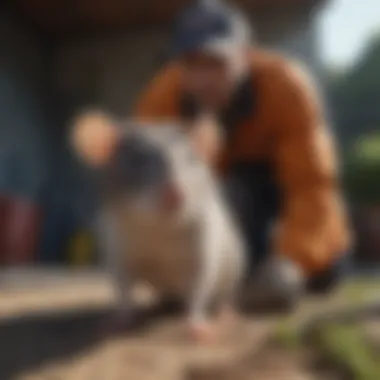Effective Strategies for Rat Elimination in Outdoor Environments


Preventive Pest Control Strategies
When it comes to effectively eliminating rats from outdoor spaces, starting with preventive pest control strategies is crucial. To safeguard your home against rat infestations, it is essential to implement various preventive measures.
- House Exterior Protection: Begin by sealing cracks and crevices around the exterior of your house to prevent rodents from gaining entry. Clearing debris such as woodpiles and overgrown vegetation can eliminate hiding spots for pests. Implementing strategies to keep pests from entering your home is key to rat prevention.
- Yard Maintenance: Maintaining a well-kept yard is vital in keeping pests at bay. Essential yard care routines such as mowing the lawn regularly, trimming bushes, and removing clutter can help create a pest-free environment.
- Indoor Cleanliness: Keeping the indoors clean and clutter-free is another effective strategy. Expert cleaning tips and techniques can help prevent rats from finding food sources or nesting areas inside your home. Maintaining a pest-resistant indoor environment is essential for long-term rat control.
- Garbage Disposal: Proper garbage disposal methods are essential in preventing rats. Efficiently disposing of waste, sealing trash cans tightly, and ensuring bins are secure can deter rodents from being attracted to your property.
- Other Pest Prevention Strategies: Aside from the mentioned strategies, there are innovative ways to safeguard your home from pests. Implementing exclusion methods, such as using mesh screens on vents and chimneys, can further prevent rat invasions.
Understanding Rat Behavior
Rats can be quite elusive and challenging to deal with, especially when they infiltrate outdoor spaces. Understanding rat behavior is crucial in effectively tackling infestations. By gaining insights into their habits and preferences, you can develop targeted strategies to eliminate them from your surroundings. This section delves into the intricate details of rat behavior to provide a comprehensive guide on eradicating these pests.
Rat Habits and Preferences
Rat Nesting Patterns
Rat nesting patterns play a pivotal role in their survival and proliferation. These patterns dictate where rats choose to make their homes, usually in secluded, warm, and secure areas. Understanding these nesting habits allows you to locate their hiding spots and take decisive action. Rat nesting patterns are characterized by their adaptability and tendency to create extensive networks of burrows. While this behavior aids their survival, it poses a threat to human settlements. Recognizing and disrupting these nesting patterns is essential in curbing infestations.
Food Sources Attractive to Rats
Rats are highly opportunistic and omnivorous, making them attracted to various food sources. Understanding what attracts rats to certain foods can help in implementing control measures effectively. Rats are drawn to easily accessible food, especially those with strong odors or flavors. Identifying and eliminating these attractive food sources is key to deterring rat activity. By depriving them of easily available sustenance, you can force rats to seek nourishment elsewhere, disrupting their foraging patterns and ultimately reducing their presence.
Signs of Rat Presence
Visual Indicators of Rat Activity
Visual indicators of rat activity are essential in early detection and intervention. Signs such as droppings, gnaw marks, and tracks indicate a rat infestation. Recognizing these visual cues enables timely response to prevent further proliferation. Observing and understanding these indicators aids in assessing the extent of the infestation, guiding the implementation of appropriate control measures.
Auditory Cues for Rat Infestations


Apart from visual signs, auditory cues can also signal rat infestations. Rats are nocturnal creatures, often active during the night, creating scratching, scurrying, or squeaking sounds. These noises can alert homeowners to potential rat presence. Paying attention to these auditory cues helps in pinpointing their location and devising strategies to address the infestation. Engaging in active listening can provide valuable insights into the scale and severity of the rat issue, facilitating targeted eradication efforts.
Preventive Measures
Preventive measures play a crucial role in effectively eliminating rats from outdoor spaces. By implementing proactive strategies, individuals can help prevent rat infestations before they become problematic. This section will delve into the specific elements, benefits, and considerations of preventive measures outlined in this article.
Sealing Entry Points
Identifying and Blocking Access Points
Identifying and blocking access points is a key strategy in rat control. By thoroughly inspecting outdoor areas for potential entry points, individuals can pinpoint where rats may be gaining access and take steps to seal these off. The key characteristic of this practice is its focus on denying rats entry into buildings or storage areas, cutting off their pathways and reducing the chances of infestation. This approach is a popular choice for rat prevention as it directly disrupts rats' ability to infiltrate spaces, forcing them to seek other entry points. A unique feature of identifying and blocking access points is its emphasis on thorough inspection and strategic barrier implementation, creating a fortified defense against rat intrusion. While advantageous in fortifying outdoor spaces, one potential disadvantage is the time and effort required to identify and seal off all possible entry points effectively.
Installing Mesh Screens and Sealants
Installing mesh screens and sealants is a proactive measure to fortify outdoor structures against rat entry. By covering vents, openings, and small gaps with mesh screens and sealing cracks with appropriate sealants, individuals can significantly reduce the likelihood of rats finding their way indoors. The key characteristic of this approach lies in its physical barrier creation, blocking potential entry routes for rats and other pests. This method is a popular choice for rat control as it provides a tangible defense against unwanted intruders. A unique feature of installing mesh screens and sealants is its versatility, as it can be customized to fit various entry points and structures, ensuring comprehensive protection. While advantageous in creating barriers, a potential disadvantage is the need for regular maintenance to monitor and repair any damages that could compromise the effectiveness of these defenses.
Natural Repellents
In the realm of pest control, natural repellents play a significant role in warding off unwanted critters like rats from outdoor spaces. These eco-friendly alternatives offer a humane and non-toxic approach to pest management, aligning with the ethos of sustainable living. Natural repellents not only serve as a deterrent but also contribute to creating a safer environment for households, particularly for those with children and pets. By incorporating natural repellents into your outdoor rat elimination strategy, you are opting for a holistic and environmentally conscious solution that targets pests effectively.
Peppermint Oil
Creating Peppermint Oil Sprays:
Creating peppermint oil sprays is a pivotal aspect of utilizing natural repellents to combat rat infestations. The distinctive scent of peppermint is highly offensive to rodents, acting as a powerful deterrent. This method involves mixing peppermint oil with water and other essential oils to create a potent spray that can be applied to target areas around the outdoor space. The strong aroma of the spray interferes with the rat's sense of smell, making the area inhospitable for them. The ease of concocting peppermint oil sprays at home makes it a cost-effective and convenient choice for households looking to get rid of rats naturally.
Placing Cotton Balls Soaked in Peppermint Oil:


Another practical approach to utilizing peppermint oil as a natural rat repellent is by soaking cotton balls in the oil and strategically placing them in rat-prone areas. The absorbent nature of cotton allows it to hold the scent of peppermint effectively, ensuring a long-lasting barrier against potential rodent invasions. By dispersing these scented cotton balls strategically, you can create a protective shield around your outdoor space, deterring rats from approaching or nesting in the vicinity. This method offers a hassle-free and non-intrusive method of rat control, making it an appealing choice for homeowners seeking a natural solution.
Predator Urine
Application Techniques for Predator Urine:
The utilization of predator urine in rat repellent strategies involves applying the scent of natural predators, such as foxes or coyotes, to create a hostile environment that deters rats. The strong smell mimics the presence of predators, triggering a survival instinct in rats that drives them away from the area. To effectively utilize predator urine, strategic application techniques are crucial. By identifying key entry points and areas of rat activity, you can strategically disperse the predator urine to maximize its repellent effect, creating a protective barrier around your outdoor space.
Effectiveness in Repelling Rats:
The effectiveness of predator urine in repelling rats lies in its ability to exploit the rodents' instincts of fear and survival. By capitalizing on these primal instincts, predator urine serves as a potent deterrent that discourages rats from venturing closer to your outdoor environment. This natural repellent method offers a non-destructive and chemical-free approach to pest control, aligning with environmentally conscious practices. While the scent may be off-putting to rats, it poses no harm to humans or other wildlife in the surrounding ecosystem, making it a safe and sustainable option for outdoor rat elimination.
Traps and Baits
Traps and baits play a pivotal role in the effective elimination of rats outdoors. Utilizing traps and baits is crucial in targeting specific rat populations and reducing infestations. These methods offer targeted solutions that are efficient and environmentally friendly, making them a preferred choice for many individuals facing rat issues.
Snap Traps
Snap traps are a traditional yet highly effective method for capturing and eliminating rats in outdoor spaces. Setting up snap traps correctly is essential to maximize their efficacy and ensure successful rat removal.
Setting Up Snap Traps Correctly
Setting up snap traps correctly involves placing them in strategic locations where rat activity is high. It is crucial to position the traps along walls or entry points, as rats tend to travel close to structures. By setting the traps perpendicular to the wall with the bait end facing the wall, you increase the likelihood of trapping rats as they explore the area.
Snap traps possess a sensitive trigger mechanism that activates when a rat disturbs the bait, swiftly capturing the rodent. This quick and humane method of trapping rats is favored for its efficiency and minimal suffering caused to the animal. The unique design of snap traps allows for easy disposal of captured rats, making them a practical choice for outdoor rat elimination.
Best Bait Choices for Snap Traps


Selecting the right bait is crucial for the success of snap traps. Peanut butter, dried fruits, or bacon are popular choices that effectively attract rats. These baits emit strong scents that entice rats to investigate the trap, increasing the likelihood of trapping them successfully.
Moreover, rotating bait options can prevent rats from becoming accustomed to a particular bait, enhancing the traps' effectiveness over time. It is essential to replace baits regularly to maintain their freshness and appeal to rats consistently.
Snap traps offer a cost-effective and reliable solution for outdoor rat removal, providing users with a hands-on approach to managing infestations.
Electronic Repellents
Innovative electronic repellents offer a modern and non-invasive way to deter rats from outdoor spaces. These devices emit sounds or vibrations that disrupt rats' sensory perception, discouraging them from lingering in the treated areas.
How Electronic Repellents Work
Electronic repellents operate by emitting high-frequency sound waves that are unbearable to rats but harmless to humans and pets. These ultrasonic waves create a hostile environment for rats, prompting them to evacuate the area to seek refuge elsewhere.
The key advantage of electronic repellents is their non-toxic nature and environmentally friendly attributes. They provide a safe alternative to chemical repellents, ensuring the well-being of other wildlife in the surroundings.
Placement for Maximum Efficacy
To maximize the efficacy of electronic repellents, proper placement is essential. Positioning the devices near areas of high rat activity, such as entry points or nesting sites, can enhance their effectiveness. Additionally, ensuring unobstructed transmission of sound waves improves the repellents' coverage and deterrence capabilities.
Strategic placement of electronic repellents can create a barrier that deters rats from entering targeted zones, making them a valuable tool in integrated pest management strategies.
Professional Extermination Services
Professional extermination services play a vital role in effectively eliminating rats from outdoor spaces. These services offer specialized expertise and tools to tackle rat infestations comprehensively. By enlisting professionals, homeowners can benefit from targeted solutions that ensure long-term rat removal.
Seeking Professional Assistance
Benefits of Professional Extermination
Professional extermination brings several distinct benefits to the table in the context of rat elimination outdoors. Firstly, professionals possess in-depth knowledge of rat behavior, enabling them to devise strategic extermination plans tailored to specific infestation scenarios. Secondly, their access to potent rodenticides and advanced traps enhances the efficiency of eradication efforts. Additionally, professionals follow stringent safety protocols, minimizing risks associated with handling toxic substances and ensuring a secure environment for homeowners and their families.
Choosing Reputable Extermination Companies
When selecting a professional extermination service, opting for reputable companies is paramount. Reputable companies boast a proven track record of successful rat removal, instilling confidence in their ability to deliver effective results. Furthermore, choosing established companies ensures reliability and accountability throughout the extermination process. By vetting the reputation and credentials of extermination providers, homeowners can make an informed decision that maximizes the likelihood of eradicating rats from outdoor spaces.



